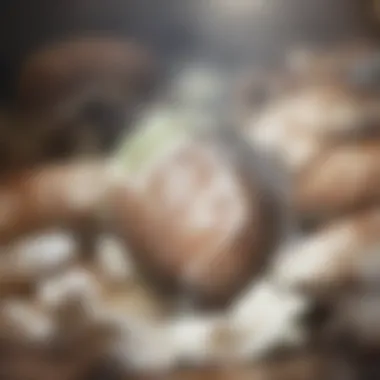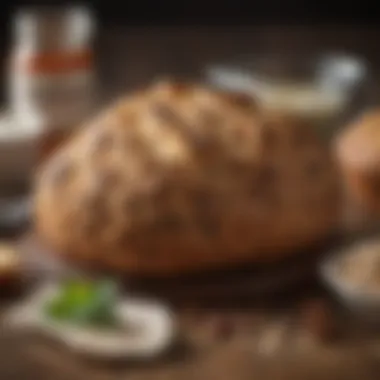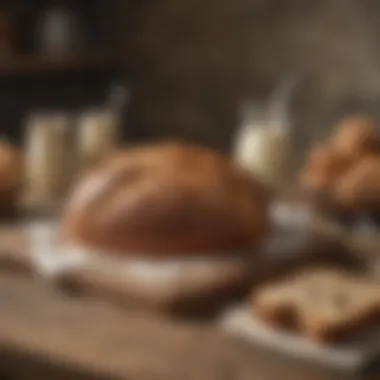Discovering the Finest Irish Soda Bread Around You


Intro
Irish soda bread, a staple of traditional Irish cuisine, has a fascinating history and simple foundation. This bread is unique in its leavening method, relying on baking soda rather than yeast. This feature not only distinguishes the bread but also enhances its appeal across various palates. In this article, we will navigate the complexities of this beloved dish, from its rich past to the best local bakeries where it can be found.
Recipe Overview
Brief Description of the Dish
Irish soda bread is characterized by its rustic texture and slightly tangy flavor. It offers a crumbly but soft experience, making it suitable for a range of toppings, including butter, jams, or simply served plain. Traditionally, it is a quick bread, which means it requires less time and expertise to prepare compared to yeast-based options.
Key Ingredients
The essential ingredients that define Irish soda bread include:
- All-purpose flour: The backbone of the bread; it provides a sturdy base.
- Baking soda: The leavening agent that differentiates it from other breads.
- Buttermilk: Offers moisture and a subtle tang, crucial for the chemical reaction with baking soda.
- Salt: Enhances flavor and acts as a purifier.
Preparation Guidelines
Step-by-Step Instructions
- Mix dry ingredients: Combine the all-purpose flour, baking soda, and salt in a large bowl.
- Add wet ingredients: Create a well in the center and pour in the buttermilk. Gently mix until a dough forms.
- Knead: Turn the dough onto a floured surface. Knead lightly for about 1-2 minutes until it comes together. Avoid over-kneading, as this makes the bread tough.
- Shape and score: Form into a round loaf. Score a deep cross on the top to allow for even cooking and to release steam.
- Bake: Preheat the oven to 425°F (220°C) and bake for about 30 minutes or until golden brown.
Preparation Tips and Tricks
For those seeking to perfect their Irish soda bread, consider the following tips:
- Use fresh baking soda: An effective leavening agent is crucial for the desired rise and texture.
- Control moisture: Adjust buttermilk quantities as needed; the dough should be slightly sticky.
- Experiment with add-ins: While traditional recipes are great, ingredients like raisins or caraway seeds add a delightful twist.
"Every loaf of Irish soda bread tells a story of resourcefulness and tradition, bridging generations through its simplicity and taste."
Understanding the foundations of Irish soda bread enriches one's appreciation for its role in Irish culture and cuisine. Recognizing quality bread is essential, especially when exploring local bakeries. Always look for its crusty exterior and on the inside, a soft, evenly textured crumb. With this guide, you can identify the finest Irish soda bread available in your area.
Prologue to Irish Soda Bread
Irish soda bread is much more than just a simple loaf; it is a reflection of cultural heritage and culinary tradition. Understanding this bread helps us appreciate not only its taste but also the history and customs surrounding it. In this section, we will explore the historical context and cultural significance of Irish soda bread, establishing its importance in both dining and domestic life in Ireland and beyond.
History and Origins
The origins of Irish soda bread trace back to the early 19th century, when it became a staple among the Irish population. The introduction of baking soda as a leavening agent changed the way bread was made, allowing for quicker preparation compared to the traditional yeast-based methods that required longer fermentation. This was particularly significant for rural communities facing limited time and resources.
The first recipes for soda bread were simple and used basic ingredients such as flour, baking soda, salt, and buttermilk. These ingredients were accessible and affordable for all households. Over time, regional variations emerged, incorporating other elements like raisins, caraway seeds, or even oats, reflecting local tastes and resources.
"Irish soda bread stands as a testament to ingenuity—transforming humble ingredients into a beloved staple."
This adaptability enabled Irish soda bread to become a central part of the Irish diet. Its popularity quickly spread to Irish immigrants in other countries, particularly the United States, where variations evolved further, sometimes deviating significantly from traditional recipes.
Cultural Significance
Irish soda bread occupies a prominent place in Irish folklore and tradition. It is commonly associated with gatherings, celebrations, and feasts. The preparation of this bread often involves familial ties, with generations passing down cherished recipes. Each family might have their own slight variations, which symbolize heritage and communal identity.
The symbolism of the cross traditionally marked on the top of the bread serves multiple purposes. It is said to ward off evil and is also a means to facilitate even cooking. This practice embodies a connection with superstitions and beliefs that have shaped Irish life for centuries.
In modern times, Irish soda bread is often featured in restaurants worldwide, elevating its status beyond mere sustenance. It is recognized for its comforting qualities and unique flavor profile, serving both palates and a sense of belonging, particularly among those with Irish ancestry.
Understanding the history and cultural significance of Irish soda bread is key to appreciating its role in various culinary contexts. From traditional meals to contemporary dining experiences, its influence can be seen and tasted, making it a subject worthy of exploration.


Understanding Irish Soda Bread
Understanding Irish soda bread is essential for anyone looking to appreciate this cornerstone of Irish cuisine. This article highlights its significance, from the basic ingredients that define it to the various ways it can be prepared and enjoyed. Recognizing the characteristics of quality Irish soda bread is beneficial both for personal endeavors in baking and for making informed choices when purchasing from local sources. A deeper knowledge of the bread's components and variations allows enthusiasts to engage more meaningfully with this cherished food tradition.
Ingredients Overview
Baking Soda
Baking soda is a key leavening agent in Irish soda bread. It reacts with buttermilk, producing carbon dioxide bubbles that help the bread rise. This chemical reaction is critical because it differentiates soda bread from yeast-based breads, which rely on fermentation for leavening. The primary advantage of using baking soda is efficiency; it allows for a quicker preparation time. However, it requires precise measurements. If too much baking soda is used, the taste can become overly bitter or soapy.
Buttermilk
Buttermilk not only adds moisture to the dough but also contributes a distinct tart flavor that balances the sweetness of the bread. This ingredient is acidic, which is essential for activating the baking soda. Buttermilk's role enhances flavor complexity and gives the bread its characteristic crumb. A potential downside is that not every home baker readily has buttermilk on hand. Substituting with milk and vinegar can work but may not yield the same richness in taste.
Flour Types
Different types of flour can influence the overall texture and flavor of the soda bread. Traditionally, white flour is favored for its fine texture, yet whole wheat flour brings a nuttier profile and added nutrition. The choice of flour impacts the density and moisture of the bread. Using a combination of both flours can yield a nice balance between traditional taste and health benefits. However, flour varies in protein content, and selecting the wrong type can lead to inconsistent bread quality.
Types of Irish Soda Bread
Traditional Recipes
Traditional recipes for Irish soda bread typically involve simple ingredients: flour, baking soda, salt, and buttermilk. This simplicity is what makes it relatable and approachable for bakers of all skill levels. The traditional approach produces a rustic loaf with a hearty flavor and dense texture. However, some might find it less versatile for culinary experimentation due to its straightforward nature. Yet, its authenticity remains a point of pride for many.
Variations Across Regions
Across Ireland, regional variations of soda bread have emerged. For example, in Kerry, added ingredients such as caraway seeds or currants can be found in recipes. Each region has its twist, influenced by local preferences or available resources. This variability showcases the adaptability of soda bread, allowing bakers to infuse personal and cultural touches. However, being aware of these differences is crucial to understanding the authenticity of what one consumes.
Modern Interpretations
Modern interpretations of Irish soda bread often include unique flavor additions, such as nuts, fruits, or different herbs. Bakers are experimenting freely, introducing new textures and flavors that diverge from traditional expectations. This innovation opens the door for creativity in baking, appealing to contemporary palates. But such interpretations may deviate from classic standards that some purists hold sacred. The challenge lies in balancing innovation without losing the essence of what makes Irish soda bread a beloved staple.
Searching for Quality Irish Soda Bread
Finding quality Irish soda bread is crucial for appreciating this traditional baked good. It's not just about taste, but also about authenticity and local craftsmanship. When seeking out this bread, certain factors help determine its quality. Texture, flavor profile, and crust quality contribute to the overall eating experience. Understanding these characteristics enhances your ability to identify quality soda bread, allowing you to enjoy this staple to its fullest.
Characteristics of Good Irish Soda Bread
Texture
Texture plays a significant role in the enjoyment of Irish soda bread. A quality loaf should feature a tender crumb that maintains a balance between softness and density. The texture should not feel overly dry or too moist. A well-made soda bread typically has a light, airy interior with small holes, indicating proper mixing and the right amount of leaving agent. This aspect is beneficial because it allows the bread to absorb flavors more effectively, enhancing every bite. In addition, the texture impacts the spreadability of toppings, which is an essential feature for enjoying the bread with various accompaniments.
Flavor Profile
The flavor profile of Irish soda bread is another crucial aspect. Typically characterized by a mild tanginess from buttermilk, the flavor should not be overpowering. Bread that balances the slight acidity with the richness of butter creates a pleasant eating experience. The simplicity of ingredients leads to a clean taste that can be enhanced by toppings. This subtle flavor profile is favorable for pairing with various dishes, ranging from savory soups to sweet jams. It allows the bread to shine whether enjoyed alone or complemented by other foods.
Crust Quality
Crust quality also significantly impacts the overall experience of Irish soda bread. A good crust should be golden-brown, providing a crispy contrast to the soft inside. This outer layer not only adds texture but also contributes to the overall flavor. Crispy crusts create a satisfying crunch when bitten into, enhancing the sensory experience. It is essential that the crust is not so tough that it detracts from the softness of the interior. Good crust quality is appreciated because it creates a harmonious balance between crunchy and soft, making each bite enjoyable.
Utilizing Local Resources
Bakeries
Choosing local bakeries is an excellent way to find quality Irish soda bread. Artisan bakeries often take pride in their craftsmanship, offering breads that are made with traditional recipes and quality ingredients. These establishments usually produce smaller batches, ensuring fresher products with distinct flavors. This focus on quality craftsmanship results in a bread that stands out from mass-produced options available in supermarkets.
Farmers' Markets


Farmers' markets are another great resource for sourcing quality Irish soda bread. Many local bakers sell directly at these markets, allowing consumers to speak with them about their processes and ingredients. The proximity to producers can lead to fresher options, as well. Typically, items at farmers' markets have a story behind them, increasing their appeal. Furthermore, supporting local businesses fosters community ties and promotes sustainable practices.
Online Communities
Online communities offer a valuable avenue for discovering quality Irish soda bread. These platforms, including social media groups and forums like Reddit, allow enthusiasts to share recommendations and experiences. Members often post reviews of local bakeries and even share recipes for home bakers looking to create their own versions. Engaging with these communities provides insight into popular and reputable sources, making it easier to locate nearby options.
"The richness of Irish soda bread lies not only in its taste but also in the stories and traditions it carries."
By understanding these resources and characteristics, you can elevate your experience with Irish soda bread, whether indulging in a slice from a beloved bakery or baking it yourself at home.
Local Bakeries to Consider
Local bakeries play a crucial role in the quest for authentic Irish soda bread. They often embody the spirit of the community and keep traditional baking methods alive. The emphasis on sourcing high-quality ingredients and employing skilled artisans can result in loaves that reflect both cultural heritage and individual creativity.
Visit local bakeries for the sheer authenticity they offer. Established bakers often have their unique recipes passed down through generations. This connection to history not only provides you with superior bread but also enriches your eating experience. When you choose to buy from a bakery, you support local businesses and contribute to the local economy.
Local bakeries can also offer an array of variations, including whole grain or gluten-free options, which might be less common in larger retail settings. These distinct offerings can cater to varying dietary preferences while maintaining the essence of Irish soda bread. Consider these factors when seeking the best bread near you.
Artisan Bakeries
Artisan bakeries stand out due to their commitment to craft. They often feature smaller batches of goods that embrace skill and detail. You’ll find that many artisan bakers focus on using traditional methods rather than mass production techniques.
These bakeries emphasize quality over quantity. Ingredients tend to be organic or locally sourced, ensuring freshness and flavor. Bread from artisan bakeries may have a denser texture and a more pronounced flavor, thanks to natural fermentation processes.
Additionally, the ambiance in artisan bakeries usually adds to the overall experience. A visit can involve observing the baking process and even consulting with bakers about their methods. This engagement with the craft can deepen your appreciation for the bread's complexity.
Supermarkets with Quality Offerings
While supermarkets may not provide the same artisanal feel, some have dedicated sections for high-quality baked goods. Certain chain stores collaborate with local bakers or maintain in-house baking operations to ensure the quality of products like Irish soda bread. These options can be convenient for consumers seeking quality without the need to visit a standalone bakery.
Supermarkets might offer a wide range of soda bread styles, from traditional varieties to modern interpretations. Accessibility often makes these options appealing. However, it’s important to look for brands that use genuine ingredients without overly processed additives. A few supermarkets have been recognized for their quality offerings, making them a suitable choice for those looking to experience good Irish soda bread with little effort.
Consider checking the bakery section for signs like hand-written labels or notes from the bakers. Such indicators can give you a clue about the bread's quality and production method.
"Quality often shines through in the simplest ingredients."
Take the time to explore both local bakeries and selected supermarkets. Each option offers unique benefits that can help you uncover the best Irish soda bread suited to your taste.
Making Irish Soda Bread at Home
Making Irish soda bread at home is not just a culinary endeavor; it is a connection to a long-standing tradition. Engaging in this process offers a deeper understanding of the bread’s cultural significance. Many people find joy in baking, and Irish soda bread is a perfect starting point due to its simplicity and few ingredients. Furthermore, homemade bread allows for customization; thus, bakers can create a loaf that suits their personal taste preferences.
Essential Ingredients
To make Irish soda bread, a few essential ingredients are required. The most notable are:
- All-purpose flour: This gives the bread structure.
- Baking soda: It acts as the leavening agent.
- Buttermilk: It adds moisture and tanginess.
- Salt: It enhances flavor.
These ingredients are vital for creating the characteristic texture and flavor of traditional Irish soda bread. Each one plays a specific role, contributing to the final product.
Step-by-Step Recipe
Preparation
Preparation is a key aspect of making Irish soda bread. It involves gathering ingredients, measuring them accurately, and mixing them properly. The dough is quite sticky, so it is important to have a clean, floured surface for kneading. The process is straightforward, which makes it an ideal choice for novice bakers. By following simple steps, one can achieve a successful outcome. However, care must be taken not to over-knead as this can lead to dense bread.
Baking Tips


Baking tips are essential for ensuring the bread turns out well. Preheating the oven to the right temperature is crucial. If the oven is too hot, the bread may burn on the outside while remaining raw on the inside. If it's not hot enough, the bread may not rise properly. Additionally, using a baking stone or a heavy baking sheet can promote even cooking. It's also helpful to check doneness with a skewer; it should come out clean when the bread is fully baked.
Storage Techniques
Storage techniques are important for maintaining the quality of Irish soda bread. Once it cools, the bread should be wrapped tightly in aluminum foil or placed in an airtight container. This helps retain moisture. However, unlike other breads, Irish soda bread is best eaten fresh. If you have leftovers, you can freeze portions to prolong their shelf life. This is a simple method to enjoy the bread later while preserving its taste.
Making Irish soda bread at home captures the essence of its historical roots, celebrating a tradition that many cherish.
By understanding these aspects, readers can engage more deeply with this traditional recipe. Homemade Irish soda bread can be both a delightful experience and a comforting dish.
Pairing Suggestions
Pairing suggestions are essential in enhancing the experience of enjoying Irish soda bread. They offer ways to complement flavors and textures, creating more enjoyable meal moments. Understanding what pairs well with Irish soda bread can deepen appreciation for the bread itself and elevate ordinary meals into something special. This section explores the traditional and creative ways to enjoy this classic bread.
Traditional Accompaniments
Jams
Jams are a classic choice for pairing with Irish soda bread. They add a sweet contrast to the slightly tangy flavor of the bread, especially those made from buttermilk. Raspberry or strawberry jams can be particularly delightful, as their fruity sweetness complements the bread's dense texture. This pairing remains popular for breakfast or tea time.
The key characteristic of jams is their variety. They come in many flavors, appealing to different palates. This variety makes jams a fantastic choice for many meals, allowing personal preference to dictate the best match. While jams offer sweetness, they can sometimes feel too sugary for those who prefer more savory notes. However, balancing the sweetness with a nice slice of bread enhances the overall taste.
Soups
Soups, particularly thick and hearty ones, have a natural compatibility with Irish soda bread. The bread's firm crust and soft interior make it perfect for dipping, soaking up the rich flavors of a warm bowl. Classic choices include vegetable soup or potato leek soup. These soups provide warmth and comfort, making them excellent for colder weather.
Soups are also filling, adding nutritional value to a meal. Another benefit of pairing soda bread with soup is the variety in textures it creates. The crunchy crust of the bread contrasts nicely with the smoothness of the soup. However, one must be cautious of overly watery soups, as they might not hold the bread well enough for an enjoyable experience.
Cheeses
Cheeses provide a rich and flavorful addition to Irish soda bread. Strong cheeses, like aged cheddar or creamy brie, offer an umami kick that enhances the overall taste experience. These cheeses can be enjoyed with bread during a formal meal or a casual snack session.
The strong flavors of aged cheeses are particularly beneficial as they balance the mild and tangy aspects of the bread. This combination is sought after by many cheese enthusiasts and adds a layer of sophistication to any meal. However, pairing a delicate cheese with a stronger soda bread can cause disharmony, resulting in an unbalanced flavor. Choosing the right cheese enhances the full experience.
New Pairing Ideas
Creative Spreads
Creative spreads allow for new ways to enjoy Irish soda bread. From herbal pesto to flavored hummus, these spreads can transform an ordinary slice into an extraordinary culinary delight. They provide diverse flavors that can make simple meals feel gourmet.
The unique feature of creative spreads is their versatility. One can easily blend different ingredients to match personal tastes. For example, combining sun-dried tomatoes with cream cheese offers a delightful twist. These spreads are popular for their ability to cater to various dietary needs and preferences. Yet, some spreads may overpower the bread's flavor, so a gentle hand in portioning is essential to maintain balance.
Modern Dishes
Modern dishes incorporating Irish soda bread demonstrate its culinary flexibility. For instance, using it as a base for an open-faced sandwich or a component in a savory bread pudding merges tradition with contemporary cooking techniques. Such dishes can appeal to food lovers, showcasing the bread's adaptability.
The key characteristic of modern dishes is innovation. Chefs create new contexts for the bread, allowing it to shine in unexpected roles. This not only elevates the bread but also introduces it to a wider audience. However, it can be vital to ensure that the bread used retains its integrity—a balance between innovation and honoring tradition is necessary for success.
Pairing Irish soda bread with various foods brings new dimensions to its flavor. Knowing how to pair wisely enhances enjoyment.
Epilogue
The discussion around Irish soda bread encapsulates not just a culinary treat but also a rich tapestry of history and culture. This exploration has underscored the significance of this traditional bread, particularly its enduring appeal across generations. Its unique flavor profiles and various textures cater to simple tastes while also delighting those looking for a more innovative approach to pairing and presentation.
The Ongoing Appeal of Irish Soda Bread
Irish soda bread is often viewed through the lens of its simplicity, made from basic ingredients such as flour, baking soda, and buttermilk. However, its appeal transcends mere sustenance; it is a symbol of heritage and community. The unique process of making this bread, requiring minimal kneading, encourages people to gather and share recipes, fostering a sense of connection.
"The beauty of Irish soda bread lies in its versatility. It caters to many, whether you enjoy traditional pairings or crave modern twists."
Local bakeries and home bakers alike have taken notice of the bread's wide-ranging potential. From warm, freshly baked loaves served with soups to contemporary variations incorporating nuts and fruits, the interpretations are endless. In this way, the timeless appeal is reinforced as bakers continue to innovate while respecting its roots.
Exploring the qualities of quality Irish soda bread can enhance one's culinary experience. Not only does it provide an opportunity to appreciate the skill involved, but it also encourages individuals to seek the best offerings in their area. By understanding the essential characteristics—such as texture, flavor, and crust quality—consumers can make informed choices, thus enriching their palates.







